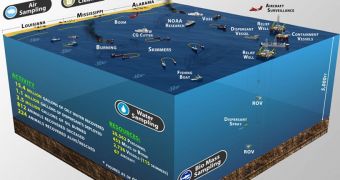A collaboration of scientists in the United States has recently pooled its resources together to produce the most up-to-date estimate of precisely how much oil is flowing in the Gulf of Mexico. The crude has been pouring into the waters since April 20, when the Deepwater Horizon semi-submersible drilling rig, operated by British Petroleum, exploded south of Louisiana. The group is made up of experts affiliated with the Flow Rate Technical Group (FRTG), and a team of scientists from the Department of Energy (DOE). The work was carried out under the direction of National Incident Commander Admiral Thad Allen.
Dr. Marcia McNutt, the director of the United States Geological Survey (USGS), leads the FRTG, while the DOE team is led by Energy Secretary Steven Chu. The collaboration combined the latest, most advanced, and most diverse methodologies for producing the new estimates, and took into account numerous factors that may influence the flow rates, and the oil spread patterns. The work is still ongoing, and the group is currently trying to determine how much oil is seeping in the Gulf since the riser above the leaking wellheads was cut, on June 3.
“Developing accurate and scientifically grounded oil flow rate information is vital, both in regards to the continued response and recovery, as well as the important role this information may play in the final investigation of the failure of the blowout preventer and the resulting spill. Top government and independent scientists are working non-stop to analyze all the information available and refine assessments being developed through numerous methodologies. I have directed Dr. McNutt and Secretary Chu to analyze the latest data and assess the various methodologies that are being used and bring them together into an updated best estimate of how much oil is now flowing from BP’s well. They will have that updated best estimate in the coming days,” Admiral Allen says.
“Each of the methodologies that the scientific teams is using has its advantages and shortcomings, which is why it is so important that we take several scientific approaches to solving this problem, that the teams continue working to refine their analyses and assessments, and that those many data points inform the updated best estimate that we are developing,” Dr. McNutt continues. The experts said that BP had been instructed by the federal government to produce precise differential pressure measurements, from both inside and outside the dome that was lowered on the wellheads. This will allow federal experts to produce an additional, independent estimate of oil flow in the Gulf.
Provided by the US Department of the Interior (source).

 14 DAY TRIAL //
14 DAY TRIAL //